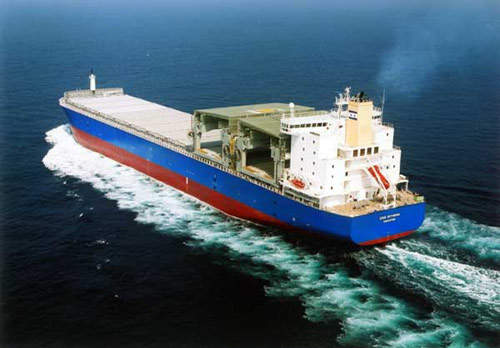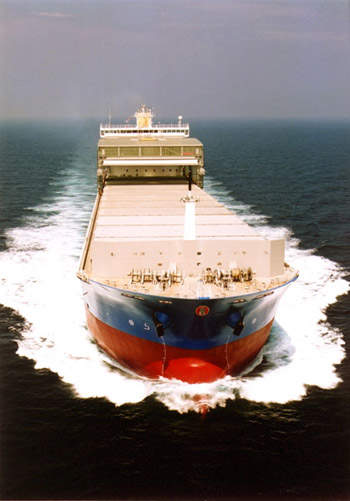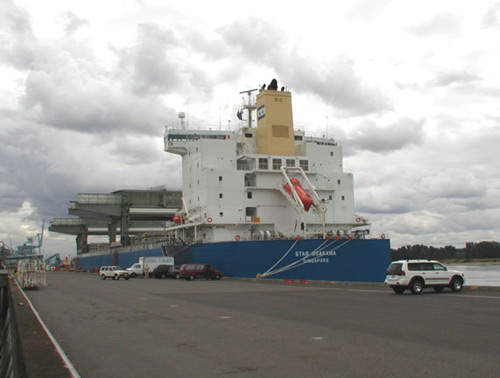The Star Osakana container / cargo bulker was designed and built by Oshima Shipbuilding of Japan for Masterbulk Pte. The vessel represents one of the four new O-class ships, the others being the Star Okiana, Star Optimana and Star Oshimana. These possess one of the largest deadweight capacities of any cargo container ship able to use the Panama Canal.
The vessel has an overall length of 199m or 189m between perpendiculars. It has a moulded breadth of 32.26m and the moulded depth to upper deck is 19m. It is a double skinned vessel, with a gap of 2.38m between skins at the side. The skins are divided by a duct keel at the centre line.
The bulker has a design draft of 11.5m and a scantling draft of 12m. It has a design deadweight of 45,656dwt and registers 36,700gross tons (or 13,900 net tons). In terms of carrying capability, it has a grain capacity of 65,338m³ or a bale capacity
of 65,298m³.
The ship can store 3,018m³ of fuel oil and137m³ of diesel oil in its bunkers. It also has water ballast tanks with a capacity of 16,180m³. The ship employs a Nakakita ballast control system.
The accommodation and bridge facilities are located aft. The vessel is manned by a complement of 14 officers and 11 crew.
CARGO CAPACITY
The vessel has a total of 11 cargo holds, which are sealed by weatherproof pontoons on the upper deck. There are also two non-weatherproof decks that can be fitted in holds 4 and 8 to form ‘tweendecks. The hatch covers are manufactured by Tsuji heavy
industries. Any unused panels are stored in hold 11.
The vessel can accommodate a total of 2,286 TEU in lengths between 20ft and 40ft. There are also 22 reefer plugs available for refrigerated units. In the holds they can be arranged in four tiers, 11 across, and on the upper deck in three or four tiers, 11 across.
GANTRY CRANES
A pair of computer-controlled muckloader-type electric travelling gantry cranes are able to traverse the length of the ship. These are the biggest gantry cranes in the world by Kone/Munck and are capable of lifts of 32 units of 8 bale pulp, double the capacity of other open-hatch ships.
The two cranes each have a lifting capacity of 68t and they can winch at 24m/min. They are also able to be turned through 190° and operate over the shipside by means of extending arms. To protect against rain, etc. while loading and unloading the cargoes, a fixed roof is located over the gantry.
POWER, PROPULSION AND MANOEUVRING
The main engine is a MAN B&W 6S60MC design manufactured by Kawasaki Heavy Industries. It has an output of 11,515kW at 101rpm. It is connected to a nickel-aluminium-bronze fixed pitch propeller, manufactured by the Nakashima propeller company. The 6,600mm-diameter propeller is driven at 97.5rpm. This gives a service speed of 16.1 knots at 90% MCR.
Steering is assisted by a Schilling high lift rudder. For manoeuvring in port, there is a Rolls-Royce bow thruster with an output of 1,500kW and a stern thruster with an output of 940kW, enabling her to dock and undock without the assistance of tugs.
Electricity is provided by three gensets. There are two STX-MAN B&W 6L28/32H engines, each linked to a Hyundai HFC 6 566-14K-SB-2 alternator with an output of 1,470kVA and a STX-MAN B&W 5L28/32H engine connected to a Hyundai HFC6 566-14K-SB-1
alternator with an output of 1,250kVA.
The vessel is classified by Det Norske Veritas under the notation +1A1 General Cargo Carrier Container, HC-EA, Grain-U,EO,LCS,(DGIS), Dk+ Ha+ IB+ 2286TEU, and TMON, NAUTICUS.







